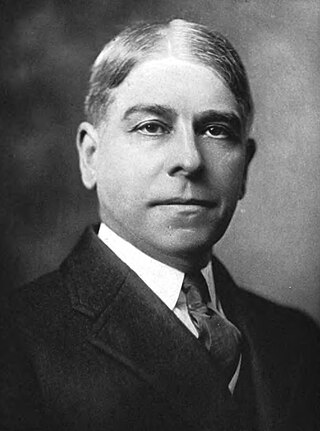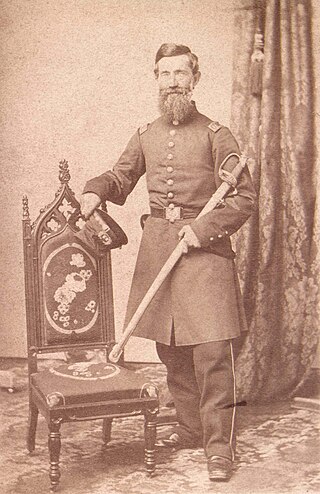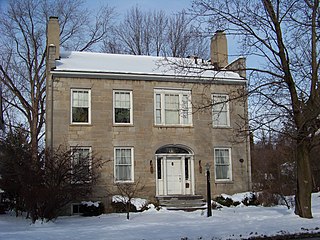
Onondaga County is a county in the U.S. state of New York. As of the 2020 census, the population was 476,516. The county seat is Syracuse.

Louis Comfort Tiffany was an American artist and designer who worked in the decorative arts and is best known for his work in stained glass. He is the American artist most associated with the Art Nouveau and Aesthetic movements. He was affiliated with a prestigious collaborative of designers known as the Associated Artists, which included Lockwood de Forest, Candace Wheeler, and Samuel Colman. Tiffany designed stained glass windows and lamps, glass mosaics, blown glass, ceramics, jewellery, enamels, and metalwork. He was the first design director at his family company, Tiffany & Co., founded by his father Charles Lewis Tiffany.

Fairmount is a hamlet in Onondaga County, New York, United States. Fairmount is a western suburb of Syracuse, located in the far southeastern corner of the town of Camillus. Its zip code is 13219 (Syracuse). It is located within the West Genesee Central School District. The population was 10,224 at the 2010 census.

LaFayette is a town in Onondaga County, New York, United States. As of the 2020 Census, its population was 4,910. The town is named after the Marquis de Lafayette, a key figure in the French and American revolutions, and widely considered a national hero of France and the United States. LaFayette is in the southern part of Onondaga County, south of Syracuse.

Pompey is a town in the southeast part of Onondaga County, New York. As of the 2020 Census, the population was 7,080. The town was named after the Roman general and political leader Pompey by a late 18th-century clerk interested in the Classics in the new federal republic.

The Onondaga Limestone is a group of hard limestones and dolomites of Devonian age that forms geographic features in some areas in which it outcrops; in others, especially its Southern Ontario portion, the formation can be less prominent as a local surface feature.

The Upstate Medical University Arena is a multi-purpose arena located in Syracuse, New York. It is part of the Oncenter Complex. Designed by Edgarton and Edgarton and built from 1949 through 1951, the structure is significant as an example of a World War I, World War II and Aroostook War commemorative and as "an early and sophisticated example of single-span thin-shell concrete roof construction." It was listed on the National Register of Historic Places in 1988. The Upstate Medical University Arena has been renovated twice, in 1994 and 2018.

Clark Reservation State Park is a state park in Onondaga County, New York. The park is in Jamesville, NY, in the Town of DeWitt, south of Syracuse. It was the site of a large waterfall formed by melting glacial ice at the end of the last Ice Age; the plunge basin at the base of the old falls is now a small lake. James Macfarlane described the area in 1879, "On approaching the lake from the turnpike on the south side, the tourist is startled at finding himself, without any notice, on the brink of a yawning gulf, precisely like that of the Niagara River below the Falls, and nearly as deep." Clark Reservation is also noted for its many ferns; it harbors the largest population in the U.S. of American hart's tongue, which is so rare that it was declared endangered in the U.S. in 1989.

Walter Warren Magee was an American lawyer and politician from New York. He was most notable for his service as a member of the United States House of Representatives; elected as a Republican in 1914, he served from 1915 until his death.
George Hall was a United States representative from New York.
Taunton is a hamlet in the Town of Onondaga in Onondaga County, New York, United States, southwest of the city of Syracuse. Landmarks of Taunton are the former Morey's Mill, once a popular source of apple cider, and Wolf Hollow, an estate created by William S. Andrews, Judge of the New York Court of Appeals, and his wife, noted author Mary Raymond Shipman Andrews. Taunton has a scenic situation amid drumlins at the foot of the Appalachian Plateau escarpment. Taunton was served by an interurban trolley line that connected the cities of Syracuse and Auburn, passing through nearby Split Rock. The trolley right-of-way has become Onondaga Boulevard.
Ephraim Webster was the first white settler in Central New York when he arrived in 1786 to an area later named Syracuse. For three decades, the Onondagas trusted him more than any other non-tribe member.
Nehemiah Hezekiah Earll was a 19th Century American lawyer and politician who served one term as a U.S. Representative from New York from 1839 to 1841.

Silas Titus was a military officer who fought in the American Civil War in the Union Army. He was active in the organization of the city of Syracuse, New York, and served as an alderman for two years and as a supervisor in 1865. He was influential in the construction of the first 30 miles of continuous railroad in the United States.

The John Gridley House is located in the southern section of Syracuse, New York. This section of Syracuse was originally known as Onondaga Hollow, and was settled thirty years before the City of Syracuse. The John Gridley House is significant as one of few houses remaining of the original Onondaga Hollow settlement. The two storey Federal style house was built around 1812 of local limestone. It was added to the National Register of Historic Places in 1977.

The 122nd New York Infantry Regiment known as the "Onondagas", was an infantry regiment in the Union Army during the American Civil War.

Clarence is a hamlet and census-designated place (CDP) within the town of Clarence in Erie County, New York, United States. The population was 2,646 at the 2010 census.
Syracuse is a city in Central New York sited on the former lands of the Onondaga Nation. Officially incorporated as a village in 1825, it has been at a major crossroads over the last two centuries, first of the Erie Canal and its branch canals, then on the railway network. The city grew on the back of its salt and chemical industries, and later as a center of manufacturing and engineering. Although its industries have dwindled, the city has remained the economic and educational hub of Central New York, a region with over a million inhabitants; the population of the city, though, has been in decline since peaking in the 1950s.

Colonel John Wesley Yale (1832-1900), of Syracuse, New York, was a paper merchant, military officer and manager and trustee of the New York State Asylum by Gov. Theodore Roosevelt. He served the Democrats under various state and national conventions.














